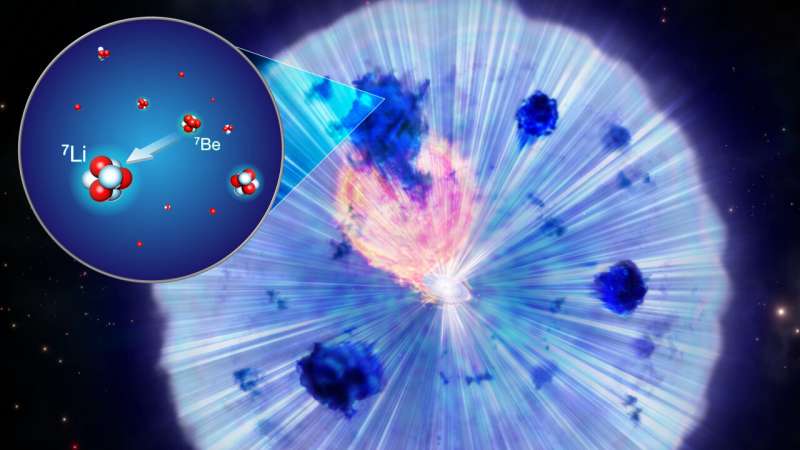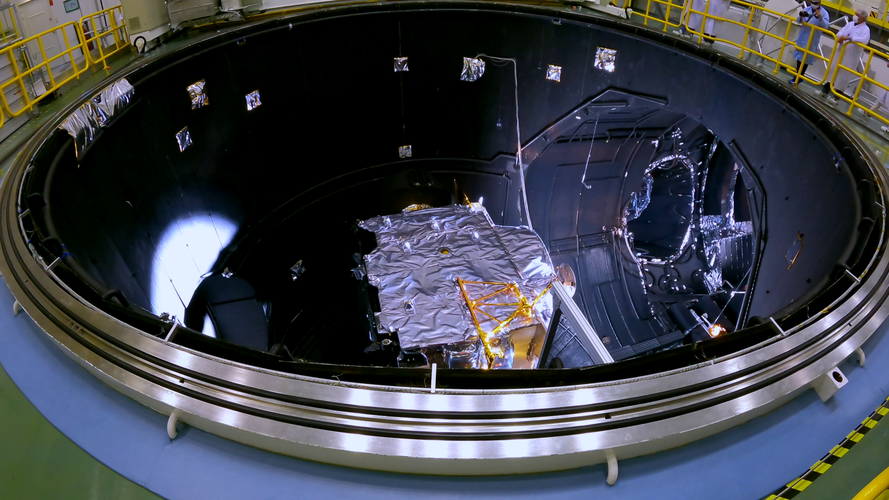
Copernical Team
Small amount of lithium production in classical nova

A new study of lithium production in a classical nova found a production rate of only a couple of percent that seen in other examples. This shows that there is a large diversity within classical novae and implies that nova explosions alone cannot explain the amount of lithium seen in the current universe.
The Making of JUICE - Episode 5
 Video:
00:05:08
Video:
00:05:08
The ESA Jupiter Icy Moons Explorer (Juice) team has been working very hard to prepare the spacecraft for the first test in the one-year long environmental test campaign. This is the so-called Thermal Balance Thermal Vacuum (TBTV) test.
Juice is in the Large Space Simulator (LSS), a unique facility in Europe (run by the European Test Center, at ESA/ESTEC in the Netherlands) that can simulate the vacuum and cold and hot temperature conditions in space, and also the Sun itself!
The TBTV started on 17 June with the closure of the LSS and the "pumping-down", meaning the removal of
New satellite data techniques reveal coastal sea-level rise

For the hundreds of millions of people living in coastal regions around the world, rising seas driven by climate change pose a direct threat. In order for authorities to plan appropriate protection strategies, accurate information on sea-level rise close to the coast is imperative. For various reasons, these measurements are difficult to get from satellites. However, new ESA-funded research demonstrates how a specific way of processing satellite altimetry data now makes it possible to determine sea-level change in coastal areas with millimetre per year accuracy, and even if the sea is covered by ice.
International Space Station update: June in orbit

Just over two months into his Alpha mission, ESA astronaut Thomas Pesquet has performed three spacewalks and supported numerous European and international experiments in microgravity. As the International Space Station crew embark on another busy month in low-Earth orbit, we reflect on some highlights from June.
Tiangong: astronauts are working on China's new space station - here's what to expect
 Three astronauts on China's new space station have just performed the country's first space walk and are busy configuring the module for future crews. Named Tiangong ("heavenly palace"), the station is the Chinese National Space Agency (CNSA)'s signature project to develop China's ambitions for having humans in orbit around Earth for a long amount of time.
In planning since the late 1990s,
Three astronauts on China's new space station have just performed the country's first space walk and are busy configuring the module for future crews. Named Tiangong ("heavenly palace"), the station is the Chinese National Space Agency (CNSA)'s signature project to develop China's ambitions for having humans in orbit around Earth for a long amount of time.
In planning since the late 1990s, Pathfinder satellite paves way for constellation of tropical-storm observers
 The 2020 Atlantic hurricane season was one of the most brutal on record, producing an unprecedented 30 named storms. What's more, a record-tying 10 of those storms were characterized as rapidly intensifying - some throttling up by 100 miles per hour in under two days.
To provide a more consistent watch over Earth's tropical belt where these storms form, NASA has launched a test satellite,
The 2020 Atlantic hurricane season was one of the most brutal on record, producing an unprecedented 30 named storms. What's more, a record-tying 10 of those storms were characterized as rapidly intensifying - some throttling up by 100 miles per hour in under two days.
To provide a more consistent watch over Earth's tropical belt where these storms form, NASA has launched a test satellite, Kepler telescope glimpses population of free-floating planets
 Tantalising evidence has been uncovered for a mysterious population of "free-floating" planets, planets that may be alone in deep space, unbound to any host star. The results include four new discoveries that are consistent with planets of similar masses to Earth, published in Monthly Notices of the Royal Astronomical Society.
The study, led by Iain McDonald of the University of Manchester
Tantalising evidence has been uncovered for a mysterious population of "free-floating" planets, planets that may be alone in deep space, unbound to any host star. The results include four new discoveries that are consistent with planets of similar masses to Earth, published in Monthly Notices of the Royal Astronomical Society.
The study, led by Iain McDonald of the University of Manchester Satellite galaxies can carry on forming stars when they pass close to their parent galaxies
 Historically most scientists thought that once a satellite galaxy has passed close by its higher mass parent galaxy its star formation would stop because the larger galaxy would remove the gas from it, leaving it shorn of the material it would need to make new stars. However, for the first time, a team led by the researcher at the Instituto de Astrofisica de Canarias (IAC), Arianna di Cintio, ha
Historically most scientists thought that once a satellite galaxy has passed close by its higher mass parent galaxy its star formation would stop because the larger galaxy would remove the gas from it, leaving it shorn of the material it would need to make new stars. However, for the first time, a team led by the researcher at the Instituto de Astrofisica de Canarias (IAC), Arianna di Cintio, ha SwRI-led team addresses mystery of heavy elements in galactic cosmic rays
 Scientists have used data from the Southwest Research Institute-led Magnetospheric Multiscale (MMS) mission to explain the presence of energetic heavy elements in galactic cosmic rays (GCRs). GCRs are composed of fast-moving energetic particles, mostly hydrogen ions called protons, the lightest and most abundant elements in the universe. Scientists have long debated how trace amounts of heavy io
Scientists have used data from the Southwest Research Institute-led Magnetospheric Multiscale (MMS) mission to explain the presence of energetic heavy elements in galactic cosmic rays (GCRs). GCRs are composed of fast-moving energetic particles, mostly hydrogen ions called protons, the lightest and most abundant elements in the universe. Scientists have long debated how trace amounts of heavy io 
 Image:
A touch of sun
Image:
A touch of sun